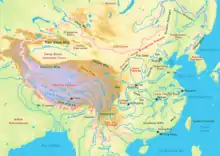North China Plain
The North China Plain (Chinese: 華北平原; pinyin: Huáběi Píngyuán) is a large-scale downfaulted rift basin formed in the late Paleogene and Neogene and then modified by the deposits of the Yellow River. It is the largest alluvial plain of China. The plain is bordered to the north by the Yanshan Mountains, to the west by the Taihang Mountains, to the south by the Dabie and Tianmu Mountains, and to the east by the Yellow Sea. The Yellow River flows through the middle of the plain into the Bohai Sea.

.png.webp)
Below the Sanmenxia Dam is the multipurpose Xiaolangdi Dam, located in the river's last valley before the North China Plain, a great delta created from silt dropped at the Yellow River's mouth over the millennia. The North China Plain extends over much of Henan, Hebei, and Shandong provinces, and merges with the Yangtze Delta in northern Jiangsu and Anhui provinces. The Yellow River meanders over the fertile, densely populated plain emptying into the Bohai Sea. The plain is one of China's most important agricultural regions, producing corn, sorghum, winter wheat, vegetables, and cotton. Its nickname is "Land of the yellow earth".
The southern part of the plain is traditionally referred to as the Central Plain (pinyin: Zhōngyuán), which formed the cradle of Chinese civilization.[1][2]
The plain covers an area of about 409,500 square kilometers (158,100 sq mi), most of which is less than 50 metres (160 ft) above sea level. This flat yellow-soil plain is the main area of sorghum, millet, maize, and cotton production in China. Wheat, sesame seed, and peanuts are also grown here. The plain is one of the most densely populated regions in the world.
Beijing, the national capital, is located on the northeast edge of the plain, with Tianjin, an important industrial city and commercial port, near its northeast coast. Shengli Oil Field in Shandong is an important petroleum base.
Historical significance
The geography of the North China Plain has had profound cultural and political implications. Unlike areas to the south of the Yangtze, the plain generally runs uninterrupted by mountains and has far fewer rivers, and as a result communication by horse is rapid within the plain. As a result, the spoken language is relatively uniform in contrast to the plethora of languages and dialects in southern China. In addition the possibility of rapid communication has meant that the political center of China has tended to be located here.[3]
Because the fertile soil of the North China Plain gradually merges with the steppes and deserts of Dzungaria, Inner Mongolia, and Northeast China, the plain has been prone to invasion from nomadic or semi-nomadic ethnic groups originating from those regions, prompting the construction of the Great Wall of China. Although the soil of the North China Plain is fertile, the weather is unpredictable, being at the intersection of humid winds from the Pacific and dry winds from the interior of the Asian continent. This makes the plain prone to both floods and drought. Moreover, the flatness of the plain promotes massive flooding when river works are damaged. Many historians have proposed that these factors have encouraged the development of a centralized Chinese state to manage granaries, maintain hydraulic works, and administer fortifications against the steppe peoples. (The "hydraulic society" school holds that early states developed in the valleys of the Nile, Euphrates, Indus and Yellow Rivers due to the need to supervise large numbers of laborers to build irrigation canals and control floods.)
References
- BASIC INFORMATION ON CHINA
- Keekok Lee (24 October 2008). Warp and Weft, Chinese Language and Culture. Strategic Book Publishing. pp. 39–40. ISBN 978-1-60693-247-6. Retrieved 2 November 2011.
- Ramsey, S. Robert, The Languages of China. Princeton University Press (1987), pp. 19-26.
External links
- Encyclopædia Britannica: "North China Plain"